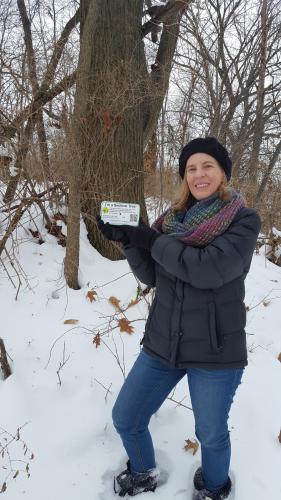The Ingham Conservation District helps keep Eyes on the Forest
Partnerships with MSU Extension help keep exotic invasive pests at bay.

The past few decades have led to an increase in impacts and awareness of exotic invasive pests and diseases on Michigan’s forests. American chestnut, American elm, beech and all ash species—among others—have already been devastated by these invaders. With each tree species that becomes threatened, the state’s overall forest resource becomes compromised.
Michigan State University Extension’s Eyes on the Forest program gives citizens an opportunity to help keep new exotic pests and diseases from attacking the forest. The program asks volunteers to adopt a ‘sentinel tree’ to periodically measure and monitor its condition. Once a sentinel tree is selected, volunteers can register it on the Midwest Invasive Species Information Network (MISIN) website. Currently there are three main threats the program is focusing on: Asian longhorned beetle, hemlock woolly adelgid, and thousand cankers disease of walnut. Although the program encourages volunteers to adopt a tree species that is vulnerable to these issues—black walnut, eastern hemlock, or a maple species, for example—any tree species can be selected.
The Eyes on the Forest program can be a great way for organizations like local parks departments, nature centers, and Conservation Districts to call attention to their own important tree and forest resources. Recently, the Ingham Conservation District (ICD) decided to identify some sentinel trees on their 200 acre property as a way to protect their own local resource and serve as an educational tool for their own volunteers.

Michelle Beloskur will attach a sentinel tree tag to her chosen black oak for future measurements. | Photo by Georgia Peterson
Walking along the snowy paths of the property, Michelle Beloskur, the ICD Director, spied a few candidates for their own Sentinel Trees. One was a sugar maple that stands along the edge of an abandoned field. The maple is not especially tall, but has a multitude of branches that could serve as a host to Asian longhorned beetle if the pest is introduced to Southern Michigan. Wintertime will be an ideal time to spy any of the telltale holes that can reach the size of a dime. She also chose a very large black walnut tree near the Conservation District headquarters. They will be able to tell if it is showing signs of thousand cankers disease most easily during the growing season if the tree’s leaves begin to turn yellow and fall prematurely. The third sentinel tree chosen was a mature black oak. Although most trees chosen for the Eyes on the Forest program are to monitor for pests and diseases that are not yet widespread in Michigan, the Conservation District is extremely concerned about oak wilt infesting their property. By choosing the oak as an additional sentinel tree, monitors will be able to keep an eye out for this disease that is spreading rapidly in the state. The ICD is hoping to use this program to spark greater interest in forest health issues.
Know of a local conservation organization who wants to keep any eye on their forest resource? Visit Michigan State University Extension’s Eyes on the Forest website for more information on this important program.



 Print
Print Email
Email
